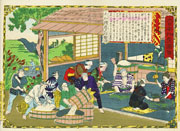Products of Greater Japan, 1877
[Dai Nippon Bussan Zue 大日本物産図会 (だいにっぽんぶっさんずえ)]
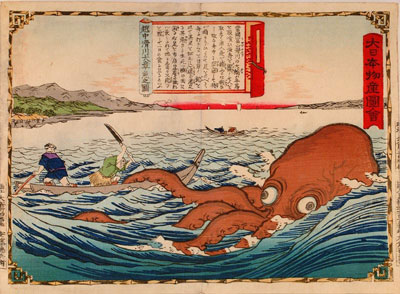
Hunting the Giant Octopus of Namekawa in Etchu province from the series Dai Nippon Bussan Zue.
The woodblock print series Dai Nippon Bussan Zue, drawn by Utagawa Hiroshige III (1842–1894), was published by the Tokyo-based publisher Ōkura Magobei on August 10, 1877. Each printed sheet in the series contained a pair of illustrations depicting regional scenes of farming, fishing, mining and other economic activities. Higuchi Hiromu, a collector of 19th-century nishiki-e, wrote in 1943 that there were 60 pairs (120 pictures) in the series, but only 118 are extant.1 There is also reference to over 100 pairs (200 pictures) being issued, based on the existence of prints in this series that carry numbers in their margin, some of which exceed the number 200. However, based upon the haphazard appearance of numbers on only the occasional print, these numbers appear to have no relationship to the total number of prints in the series and we can safely assume that only 59 pair (118 pictures) were issued.The series' issuance date strongly suggests that their publication was timed for the August 21, 1877 opening of the first National Industrial Exposition (Naikoku Kangyō Hakurankai) in Tokyo's Ueno Park. (See The 1877 First National Industrial Exhibition below.)
The Series Dai Nippon Bussan Zue 大日本物産図会 (Products of Greater Japan, 1877)
This series is also referred to as Dainippon Butsu-san Zukai (Pictures of Products and Industries of Japan) and is variously translated as Products of Greater Japan, Series of Greater Japan Products, Famous Products of Japan, Products of Japan, and Pictorial Record of Japanese Products, among others.One example of many types of bindings and distribution for this series.
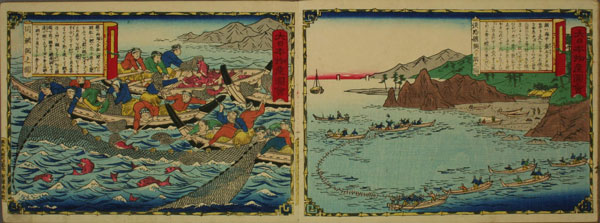

廣重筆
Hiroshige hitsu
画工
大鋸町四番地
安藤徳兵衛
gakō Ōga machi yon banchi,
Andō Tokubei
出版人
日本橋通一丁目十九番地 大倉孫兵衛
publisher, Nihobashi-dōri Itchōme 19-banchi, Ōkura Magobei
Borrowing of Scenes
Source: Picturing Westernization and Modernization: A Woodblock Print Collection from Late 19th Century Japan, Izumi Koide, June 16, 2006, a paper delivered at the WORLD LIBRARY AND INFORMATION CONGRESS: 72ND IFLA GENERAL CONFERENCE AND COUNCIL 20-24 August 2006, Seoul, Korea http://archive.ifla.org/IV/ifla72/papers/085-Koide-en.pdf
These pictures show industrial scenes such as harvesting natural resources, processing crafts, shipping products, etc. in certain regions or countries, and hence depicting local industry. In the history of Japanese drawings particularly for practical use, there were various genres of pictures: meisho-e described famous places such as temples, sight-seeing spots, etc.; shokunin-e depicted various professionals and how to make things; bussan-e were like pictorial encyclopedia for products; and hakubutsu-e were of things. The Dai Nippon Bussan Zue is a combination of these genres of picture. By presenting images of most regions in Japan systematically with respective local industries, products, and working people, it suggested the variety as well as commonality of the developing nation.
The pictures are of all regions of Japan (see Former Provinces of Japan) and it is unlikely that the artist traveled to each place. Some pictures of the series are “borrowed” from other pictures, a practice known as shakuyō. Some pictures were taken from Nihon Sankai Meisan Zue (Famous Sea and Land Products in Japan, first published in 1799), and others were from Kii Meisho Zue (Famous Places in the Kii Region) of the mid 19th century. There might exist other “originals” upon which pictures in the Dai Nippon Bussan Zue were based as there were many other regional “famous places series.”
Despite the borrowing of scenes from older originals, local industries had not changed much for decades when these prints were issued in the early Meiji period in comparison to the immense change in the political system. The pictures in Dai Nippon Bussan Zue gave people images of local industrial scenes, even if conventional or imaginary, in the age of “national industrial expositions.”
Multiple Editions
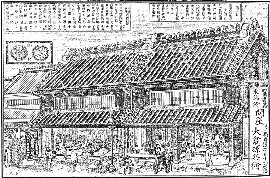
Producing Soy Sauce in Shimosa Province - Three Variations
The 1877 First National Industrial Exhibition
Source: Japan Goes to the World's Fairs: Japanese Art at the Great Expositions in Europe and the United States 1867-1904, Los Angeles County Museum, 2005, p. 46.
The First National Industrial Exhibtion (Naikoku Kangyō Hakurankai) was held from August 21 through November 30, 1877, in Tokyo's Ueno Park. The Minister of the Interior, Ōkubo Toshimichi, who acted as the exhibition's general director, was a powerful advocate for the policy of fostering production and commerce and a proponent of national industrial exhibitions. The exhibition site consisted of a museum, main hall, machinery hall, agriculture hall, animal husbandry hall, horticulture hall, Gokakudō (pentagonal hall), and Rokusō-an tea ceremony pavilion. There were a total of 16,172 exhibitors showing 84,353 items. In anticipation of the event, the government clearly stated its interest in encouraging the growth of export industries and requested that every prefecture in Japan participate in the exhibition, suggesting that the domestic fairs were intended to provide a survey of the products and industries of the entire country and to offer a venue for assessing which of those products might be suitable for export.
References
https://myrp.maruzen.co.jp/press/bussan/1 Picturing Westernization and Modernization: A Woodblock Print Collection from Late 19th Century Japan,Izumi Koide, June 16, 2006, a paper delivered at the WORLD LIBRARY ANDINFORMATION CONGRESS: 72ND IFLA GENERAL CONFERENCE AND COUNCIL 20-24August 2006, Seoul, Korea http://archive.ifla.org/IV/ifla72/papers/085-Koide-en.pdf
Notes on commonly used Kanji in print titles:
国 (or 國) kuni - province
同国 dōkoku - the same province (a reference to the province written in the cartouche of paired print)
製図 seizu - drawing or sketch
之図(or 圖) no zu (also ノ図) - picture or drawing of something
Thumbnails of the 118 Prints | Product/Work Depicted Japanese Title | Province |
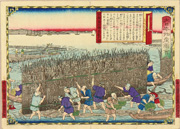 | Selling Toothpicks at Itsukushima 安芸国厳島楊枝ヲ鬻図 Aki no kuni Itsukushima yōji o iku zu Oyster Farm in Hiroshima 同[安芸]広島牡蛎蓄養之図 [同広島牡蠣畜養之図] dō [Aki] Hiroshima kaki chikuyō | Aki 安芸国 Aki no kuni  Modern-day Hiroshima prefecture (広島県) |
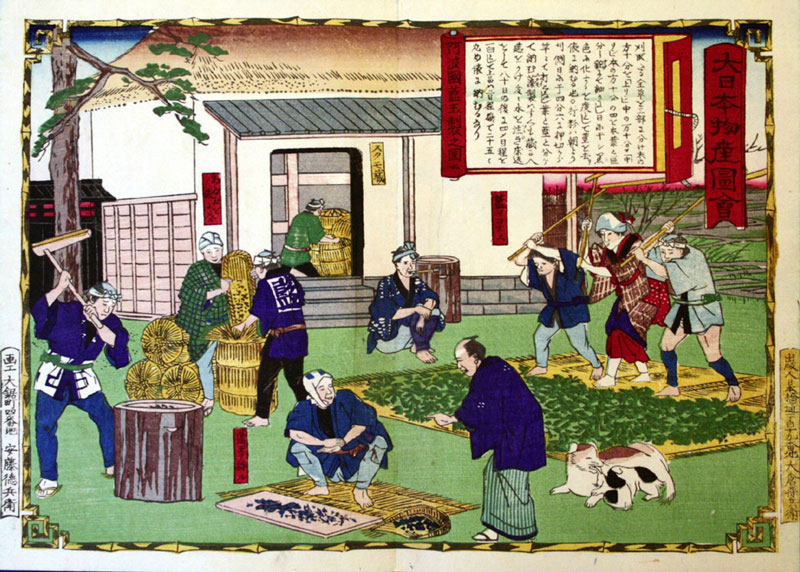 | Indigo Production (harvesting Indigofera), figure 1 阿波国藍製之図 一 Awa no kuni ai sei no zu ichi Indigo Production (preparing the leaves), figure 2 阿波国藍玉製之図 二 | Awa 阿波国 Awa no kuni  Modern-day Tokushima Prefecture (徳島県) |
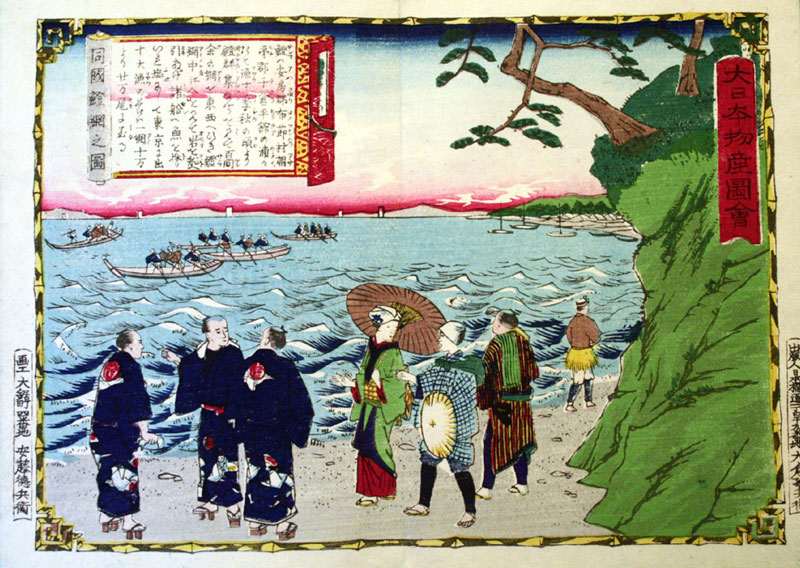 | Daffodil Flowers 安房国水仙花 Awa no kuni suisen hana Saury Netting  [同国[安房]秋刀魚網之図] dōkoku sanma ami no zu | Awa 安房国 Awa no kuni  Modern-day Chiba Prefecture (千葉県) |
| | Seabream Netting 淡路国鯛ブリ網之図 Awaji no kuni tai buri ami no zu Red Snapper Netting 同[淡路国]鯛網之図 | Awaji 淡路国 Awaji no kuni  Modern-day Hyōgo Prefecture (兵庫県) |
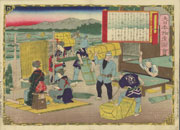 | Planting Rush 備後国藺を植ル図 Bingo no kuni rin o shoku ru zu Tatami Mat Making 備後國疊表ヲ製圖 [備後国畳表ヲ製図] Bingo koku tatamiomote o seizu | Bingo 備後国 Bingo no kuni  Modern-day Hiroshima Prefecture (広島県) |
| Slate Pencil Making in Okayama 備前岡山石筆製図 Bizen Okayama sekihitsu seizu Catching Whitefish 備前国白魚漁之図 | Bizen 備前国 Bizen no kuni 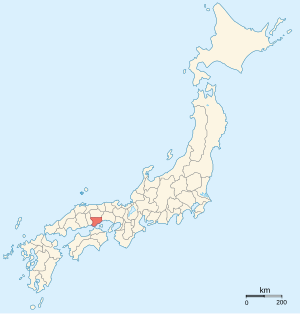 Modern-day Okayama Prefecture (岡山県) | |
| | Woven Items from Hakata 筑前国博多織之図 Chizuken no kuni hakata ori no zu Catching Tuna 筑前国鮪漁之図 Chikuzen no kuni maguro ryō no zu | Chikuzen 筑前国 Chikuzen no kuni 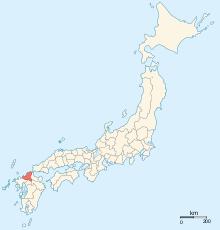 Modern-day Fukuoka Prefecture (福岡県) |
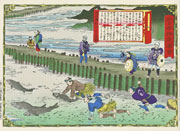 | Bleaching Fabricon the Snow 越後國雪中布晒之図 Catching Salmon 越後国鮭洲走を捕図 | Echigo 越後国 Echigo no kuni  Part of modern-day Niigata Prefecture (新潟県) |
| | Paper (hōsho) Making 越前国奉書紙製之図 Echizen no kuni hōsho shi sei no zu Gathering Sea Urchin 越前国海膽取之図 [越前国海胆取之図] Echizen no kuni uni tori no zu | Echizen 越前国 Echizen no kuni  Northern part of modern-day Fukui Prefecture (福井県) |
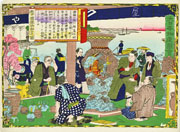 | Iron Works 越中国鉄物細工之図 Etchū no kuni tetsumono saiku no zu Giant Octopus in Namekawa 越中滑川大章魚之図 Etchū Namekawa dai tako no zu | Etchū 越中国 Etchū no kuni  Modern-day Toyama Prefecture (富山県) |
| Leather Shop in Himeji 播州姫路革店之図 Banshū Himeji kawa ten no zu Saltern in the Ako District 播磨国赤穂塩浜之図 | Harima 播磨国 Harima no kuni (also known as Banshū province 播州)  Southwestern part of modern-day Hyōgo Prefecture (兵庫県) | |
| | Silkworm Culture, figure 2 飛騨国養蚕(蠶)之図 二 Hida no kuni yōsan no zu Hunting Boar and Deer 飛州猪狩之図 [飛州猪捕之図] Hishū shishigari no zu | Hida 飛騨国 Hida no kuni (also known as Hishū province 飛州) 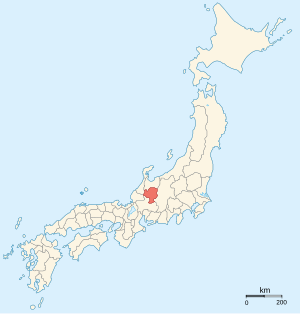 Northern part of modern-day Gifu Prefecture (岐阜県) |
| | Planting Rice 肥後国田植之図 Higo no kuni taue no zu Harvesting and Threshing rice 同刈場之図 dō kariba no zu | Higo 肥後国 Higo no kuni  Modern-day Kumamoto Prefecture (熊本県) on the island of Kyūshū (九州) |
| Silkworm Culture, figure 1 常陸国養蠶之図 一 [常陸国養蚕之図 一] Hitachi no kuni yōsan no zu ichi Catching Carp 常州鯉ヲ抱取ル図 Jōshū koi o daku toru ru zu | Hitachi 常陸国 Hitachi no kuni  Modern-day Ibaraki Prefecture (茨城県) | |
| | Manufacturing Imari Porcelain, figure 1 肥前伊万里陶器造図 一 Hizen Imari tōki tsukuru zu ichi Manufacturing Imari Porcelain, figure 2 肥前伊万里陶器造図 二 Hizen Imari tōki tsukuru zu ni | Hizen 肥前国 Hizen no kuni  Modern-day Saga (佐賀県) and Nagasaki (長崎県) Prefectures |
| Catching Sea Otter 千島国海獺採之図 Chishima no kuni rakko to no zu Shipping Ice from Hakodate, Hokkaidō 北海道函館氷輸出之図 Hokkaidō Hakodate kōri yushutsu no zu | Chishima Province 千島国 [Part of Hokkaidō 北海道 region consisting of 11 provinces] Hokkaidō 北海道 [A region consisting of 11 provinces] Hakodate 函館 [old capital of Hokkaido] | |
| Producing Vitriol 日州緑磐製之図 [日州緑礬製之図] [日向緑礬製之図] Camphor Manufacture 日向国樟脳製之図 | Hyūga 日向国 Hyūga no kuni (also known as Nisshū 日州)  Modern-day Miyazaki Prefecture (宮崎県) | |
| Polishing-Sand 伊賀国磨砂 Iga kuni migakizuna Coal Mine 同国[伊賀]石炭山之図 dōkoku sekitan yama no zu | Iga 伊賀国 Iga kuni  Modern-day municipalities of Iga (伊賀市) and Nabari (名張市) | |
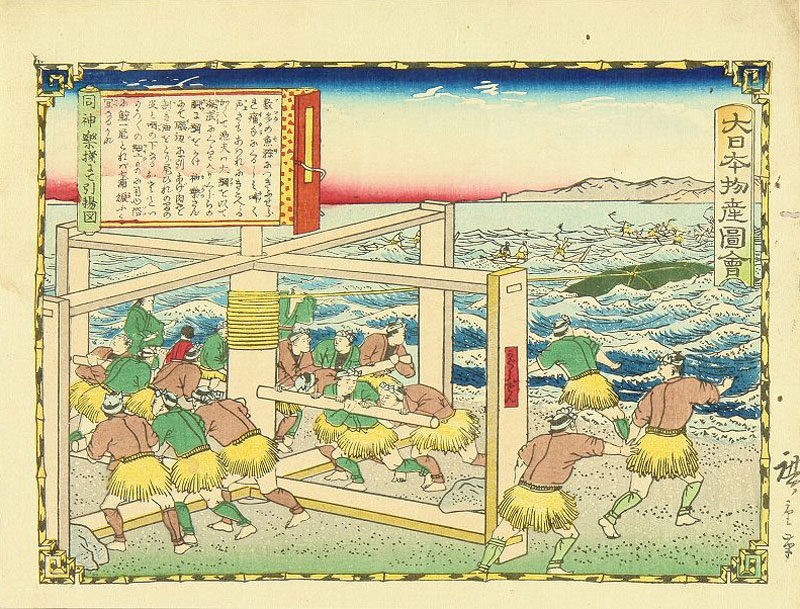 | Whale Fishing 壱岐国鯨漁之図 Iki no kuni kujira ryō? no zu Pulling Up a Whale 同[壱岐]神楽桟にて引揚図 | Iki 壱岐国 Iki no kuni  Modern-day Nagasaki Prefecture (長崎県) |
| Abalone Divers 伊勢国鮑採之図 Ise no kuni awabi tori no zu Making Dried Stretched Abalone 同国[伊勢国]長鮑製之図 dōkoku [Ise no kuni] naga awabi sei no zu | Ise 伊勢国 Ise no kuni  Most of modern-day Mie Prefecture (三重県) | |
| Silkworm Culture, figure 4 磐城国養蚕之図 四 Wild Horse Capture 磐城国野馬捕之図 | Iwaki 磐城国 Iwaki no kuni (also known as Banshū 磐州) 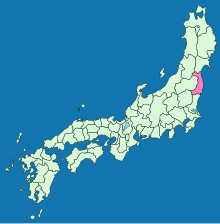 Modern-day Fukushima Prefecture (福島県) | |
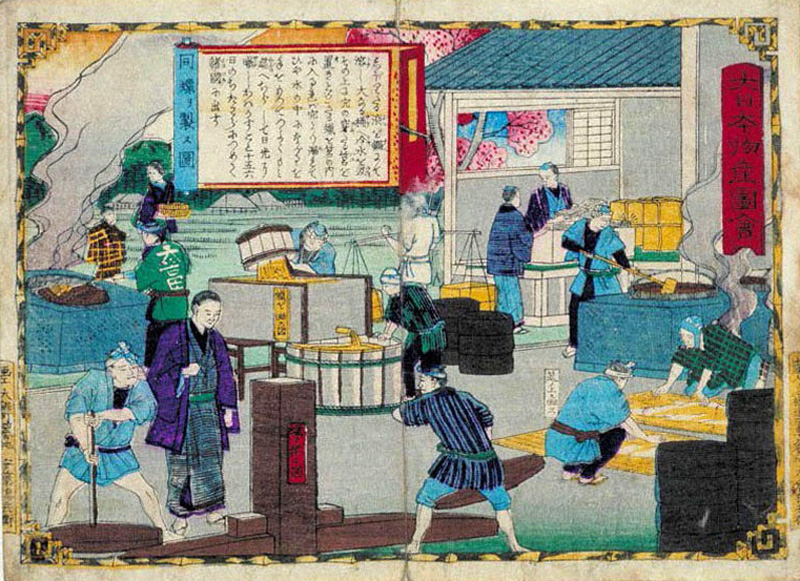 | Gathering Wax [Lacquer Tree] Nuts in Aizu 岩代国会津蝋実採ノ図 [岩代国会津蠟実採ノ図] Iwashiro no kuni Aizu rō (ka)jitsu to no zu Making Wax 同蝋ヲ製ス図 同[岩代国]蠟ヲ製ス図 dō (Iwashiro no kuni) rō o seisu zu | Iwashiro 岩代国 Iwashiro no kuni (sometimes called Ganshū (岩州)  Western half of the central part of modern-day Fukushima Prefecture (福島県) and the eastern half of modern-day Iwaki Province (磐城国) |
| | Capturing Falcons, figure 1 伊豫國鷹捕之図 一 | Iyo 伊予国 or 伊豫國 Iyo no kuni  Modern-day Ehime Prefecture (愛媛県) |
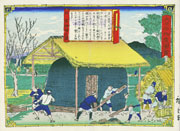 | Making Camelia Oil 伊豆國椿樹油取圖 [伊豆国椿の油を取図] Charcoal Making 伊豆国炭焼場之図 | Izu 伊豆国 Izu no kuni  The mainland portion of Izu Province, comprising the Izu Peninsula is he eastern portion of modern-day Shizuoka Prefecture (静岡県) and the Izu Islands are part of modern-day Tokyo (東京都) |
| | Swordsmith Store in Sakai 泉州堺打物見世之図 Senshū Sakai unchimono mise no zu Pink Snapper and Fish Market at Sakai Beach 和泉国堺浦桜鯛井二魚市之図 [和泉国堺浦桜鯛咲魚市之図] Izume no kuni Sakai ura ichino? uoichi no zu | Izumi 和泉国 Izumi no kuni (also known as Senshū 泉州) 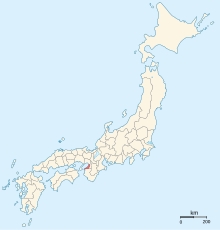 The south-western part of modern-day Osaka Prefecture (大阪府) (south of the Yamato River; not including the city of Osaka itself) |
| Bear Hunting for Gall 加州熊并ニ胆ヲ取ル図 かしゅうくまならびにきもをとるず Kashū-gama narabi ni kimo o toru zu Sedge Hat Making 加賀國菅笠ヲ造ル圖 [加賀国菅笠ヲ造ル図] | Kaga 加賀国 Kaga no kuni (also known as Kashū (加州) 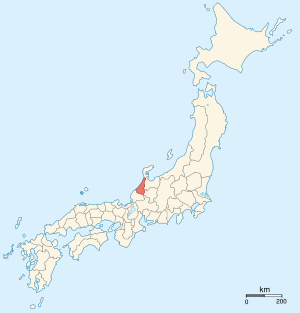 Southern part of modern-day Ishikawa Prefecture | |
| | Making White Persimmon 甲斐国白柿製之図 Kai no kuni shiro? kaki sei no zu Grape Cultivation 甲斐国葡萄培養図 Kai no kuni budō baiyō zu | Kai 甲斐国 Kai no kuni Modern-day Yamanashi Prefecture (山梨県) |
 | Harvesting and Cleaning Cotton [河内国] 木綿ヲ摘取ル図 [木綿ヲ摘採ル図] Kawachi no kuni kiwata o tekishu ru zu Cotton Textile Loom 河内木綿織機之図 Kawachi no kuni men'orimono hata no zu | Kawachi 河内国 Kawachi no kuni (also known as Kashū 河州)  Eastern part of modern-day Osaka Prefecture (大阪府) |
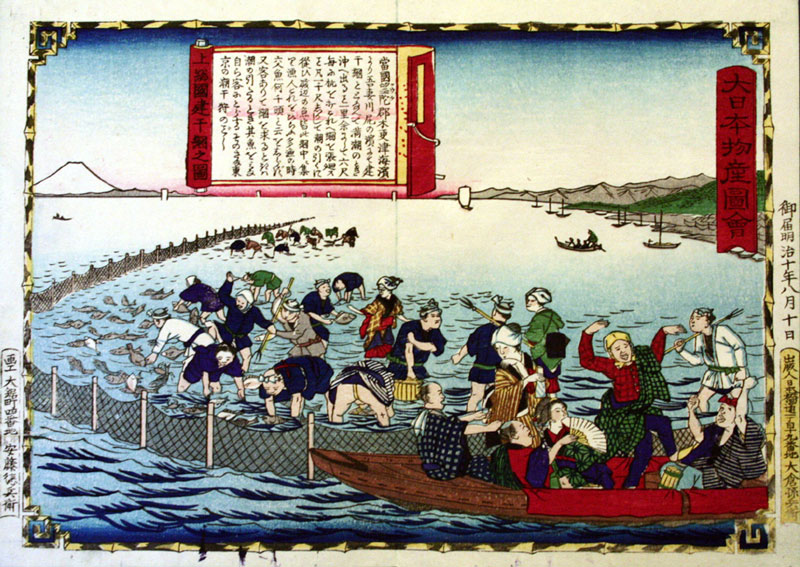 | Sardine Fishing in Kujūkuri (Yasashi Bay) 上総国 九十九里鰮猟之図 Kazusa no kuni Kujūkuri iwashi ryō no zu Erecting Drynets 上総国建干網之図 Kazusa no kuni ? no zu | Kazusa 上総国 Kazusa no kuni  Modern-day Chiba Prefecture (千葉県) |
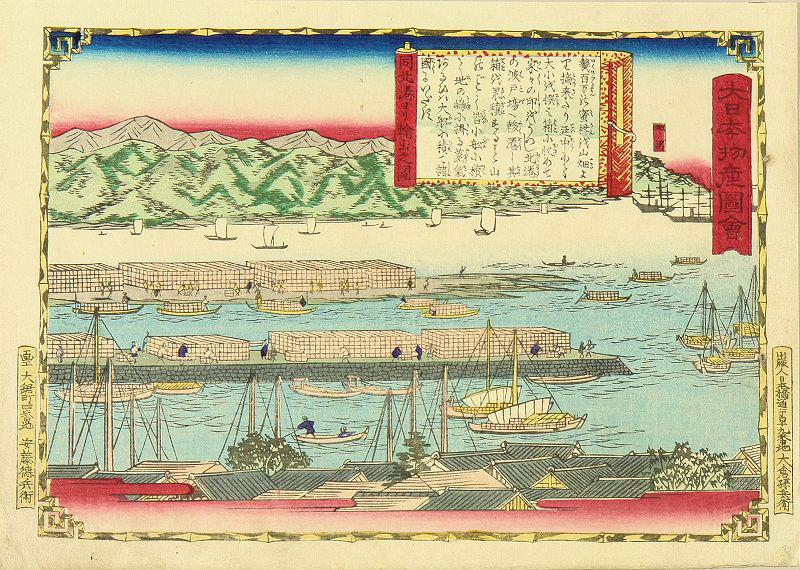 | Mandarin Orange Plantation 紀伊国蜜柑山畑之図 Exporting Products from the Port of Hokukō 同北港ヨリ積出之図 [同北港ヨリ輸出之図] dō Hokukō yori yushutsu no zu | Kii 紀伊国 Kii no Kuni  Modern-day Wakayama Prefecture (和歌山県) and the southern part of modern-day Mie Preecture (三重県) |
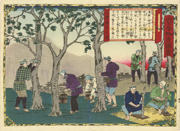 | Quarying Whetstone in Nagura 三河国名倉砥切出ノ図 Mikawa no kuni Nagura 砥 setsu shutsu no zu | Mikawa 三河国 Mikawa no kuni  Eastern half of modern-day Aichi Prefecture (愛知県) |
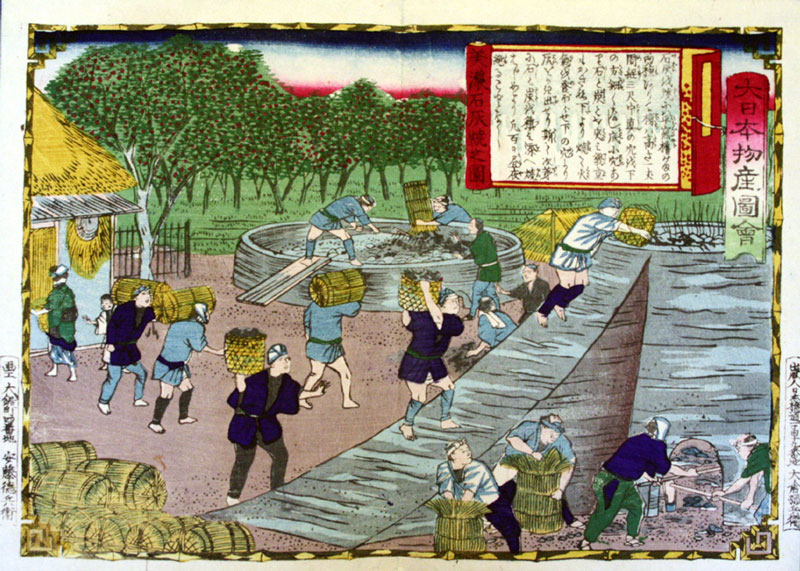 | Limestone Mountain 美濃国石灰山之図 Mino no kuni sekkai yama no zu Limestone Burning 美濃石灰焼之図 Mino sekkai shō no zu | Mino 美濃国 Mino no kuni  Southern part of modern-day Gifu Prefecture (岐阜県) |
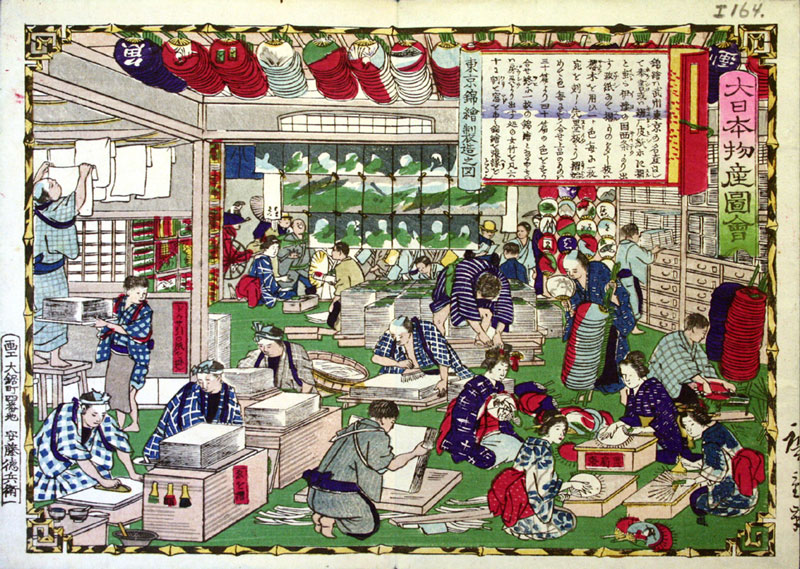 | Drying Nori 武蔵国浅草海苔製図 Musashi no kuni asakusanori seizu Making Nishiki-e in Tokyo 東京綿絵製造之図 [東京錦絵製造之図] Tokyo nishiki-e seizō no zu | Musashi 武蔵国 Musashi no kuni  Modern-day Tokyo Metropolis (東京都), most of Saitama Prefecture (埼玉県) and part of Kanagawa Prefecture (神奈川県) |
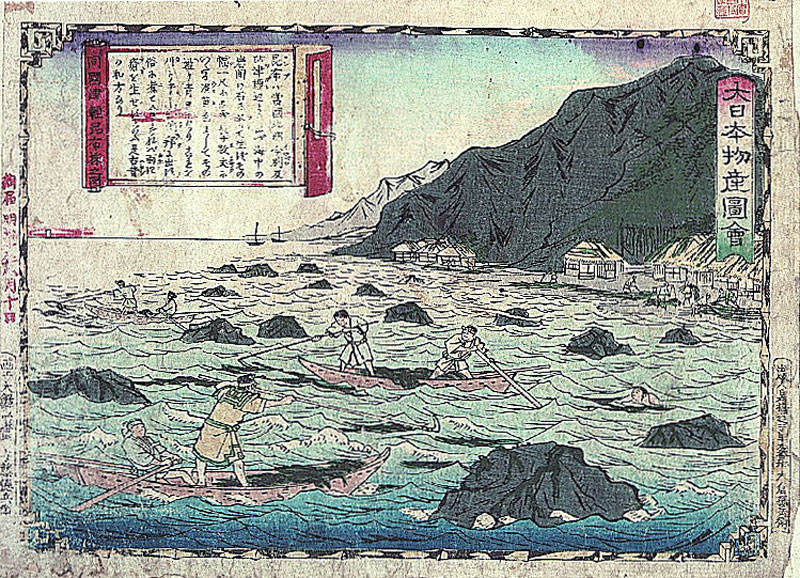 | Silk Wadding 陸奥国真錦製之図 [陸奥国真綿製之図] Mutsu no kuni mawata? sei no zu Harvesting Kelp (konbu or kombu) in Tsugaru 同国津軽昆布採之図 dōkoku Tsugaru konbu to no zu | Mutsu 陸奥国 Mutsu no kuni (also known as Ōshū (奥州) or Michinoku (陸奥 or 道奥)  Area of modern-day Fukushima (福島県), Miyagi (宮城県), Iwate (岩手県) and Aomori Prefectures (青森県) and the municipalities of Kazuno (鹿角市) and Kosaka (小坂町) in Akita Prefecture (秋田県) |
| Making Sōmen 能登素麺製造ノ図 のとそうめんせいぞうのず Noto sōmen seizō no zu Mackerel Fishing (at night) 同國(能登)鯖釣之圖 のとさばつりのず dōkoku (Noto) saba tsuri no zu | Noto 能登国 Noto no Kuni  Northern part of modern-day Ishikawa Prefecture (石川県) in Japan, including the Noto Peninsula (能登半島) | |
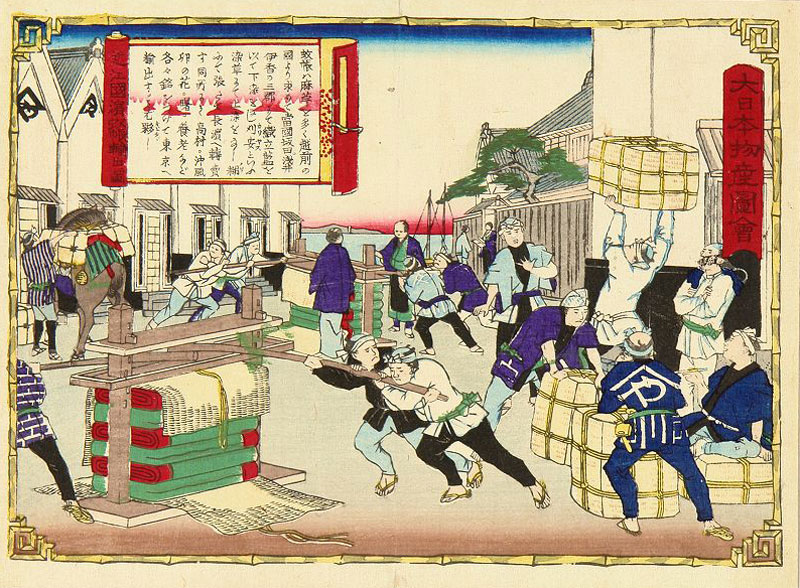 | Making "Aobanagami" (blue stained paper) 近江国青花紙製図 Ōmi no kuni aobanagami seizu Exporting Mosquito Net 近江国浜蚊帳輸出図 [近江国浜蚊帳張輸出図] オウミノクニハマカヤユシュツズ Ōmi no kuni hama? kaya yushutsu zu | Ōmi 近江国 Ōmi no kuni  Modern-day Shiga Prefecture (滋賀県) |
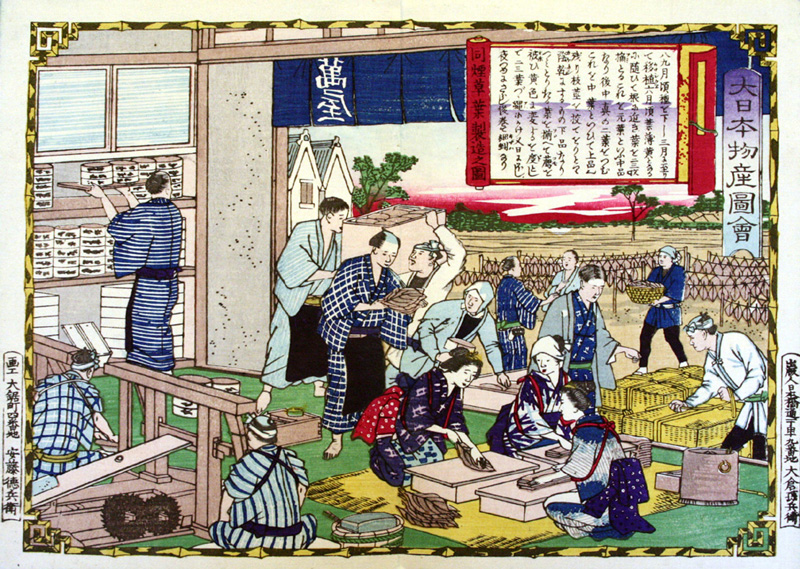 | Tobacco Cultivation 大隅国煙草培養之図 Ōsumi no kuni tabako baiyō no zu Tobacco Leaf Production 同[大隅国]煙草葉製造之図 dō [Ōsumi no kuni] tabako ha seizō no zu | Ōsumi 大隅国 (大隈国) Ōsumi no kuni (also known as Gūshū 隅州)  Eastern part of modern-day Kagoshima Prefecture (鹿児島県) |
| | Tie-dyeing in Arimatsu 尾張国有松纐リ之図 Owari no kuni Arimtasu kokuji (shibori) no zu Making Folding Fans in Nagoya 尾州名古屋扇折の図 Bishū Nagoya ōgi setsu? no zu | Owari 尾張国 Owari no kuni (also known as Bishū province 尾州) 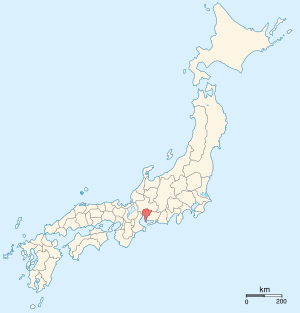 Western half of modern-day Aichi Prefecture (愛知県), including the modern city of Nagoya (名古屋市) |
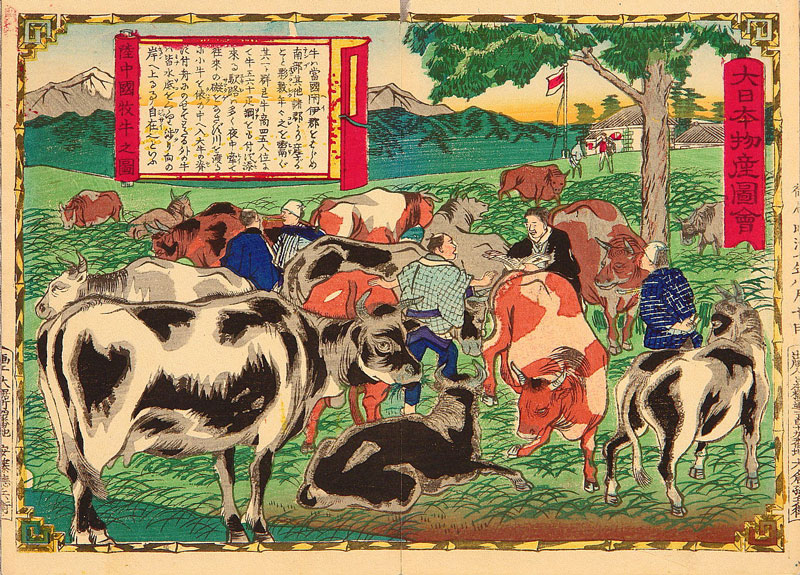 | Silkworm Culture, figure 6 陸中国養蚕之図 六 Rikuchū no kuni yōsan no zu Pasteuring Cattle 陸中国牧牛之図 Rikuchū no kuni bokugyū no zu | Rikuchū 陸中国 Rikuchū no kuni (also known as Rikushū  Modern-day Iwate (岩手県) and Akita Prefectures (秋田県) |
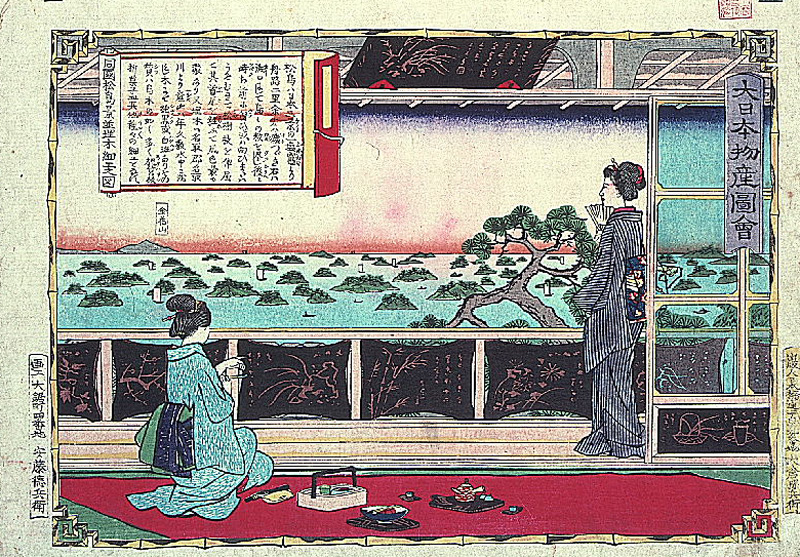 | Silkworm Culture, figure 5 陸前国養蠶図五 Rikuzen no kuni yōsan zu go Crafting Bogwood Carvings (umoregi- zaiku) in Matsushima 同国松島景並埋木細工之図 dōkoku Matsushima kei umoregi- zaiku no zu | Rikuzen 陸前国 Rikuzen no kuni (sometimes called Rikushū 陸州)  Modern-day Miyagi Prefecture (宮城県) (excluding Igu, Katta District and Watari Districts) and parts of Iwate Prefecture (宮城県) (specifically Kesen District 気仙郡) |
| | Gold Mine 佐渡国金山之図 Sado no kuni kinzan no zu Gold Mining 佐渡金掘之図 Sado kin kutsu no zu | Sado 佐渡国 Sado no kuni (sometimes called Sashū 佐州 or Toshū 渡州)  Part of modern-day Niigata Prefecture (新潟県) |
 | Making White Sugar 讃岐国白糖製造ノ図 Sanuki no kuni hakuto seizo no zu Making Sanbon Sugar 同三盆糖製造之図 dō sanbonto seizo no zu | Sanuki 讃岐国 Sanuki no kuni (sometimes called Sanshū 讃州)  Modern-day Kagawa Prefecture (香川県) |
 | Sake Brewing at Itami 摂津国伊丹酒造之図 Settsu no kuni Itami shuzō no zu Shipping New Brew Sake 同[摂津国]新酒荷出之図 dō [Settsu no kuni] shinshu shutsu no zu | Settsu 摂津国 Settsu no kuni (sometimes called Tsu Province 津国 or Sesshū 摂州) 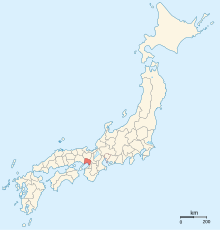 Southeastern part of modern-day Hyōgo Prefecture (兵庫県) and the northern part of Osaka Prefecture (大阪府) |
| | Harvesting Kelp (arame) 志摩國荒布刈之圖 [志摩国荒布刈之図] Shima no kuni arame kari no zu Five-colored Sand Decorative Landscapes 同[志摩]国五色砂ニテ盆石飾 dōkoku goshiki-ishi suna nite bonseki kazari | Shima 志摩国 Shima no kuni  outheastern part of modern-day Mie Prefecture (三重県) |
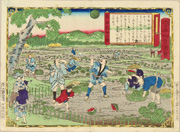 | Producing Soy Sauce 下總國醤油製造之圖 [下総国醤油製造之図] Shimōsa no kuni shoyu seizo no zu Watermelon Field 同西瓜畑之図 dō suika hatake no zu | Shimōsa 下総国 Shimōsa no kuni  In the area of modern-day Chiba Prefecture (千葉県) and Ibaraki Prefecture (茨城県) |
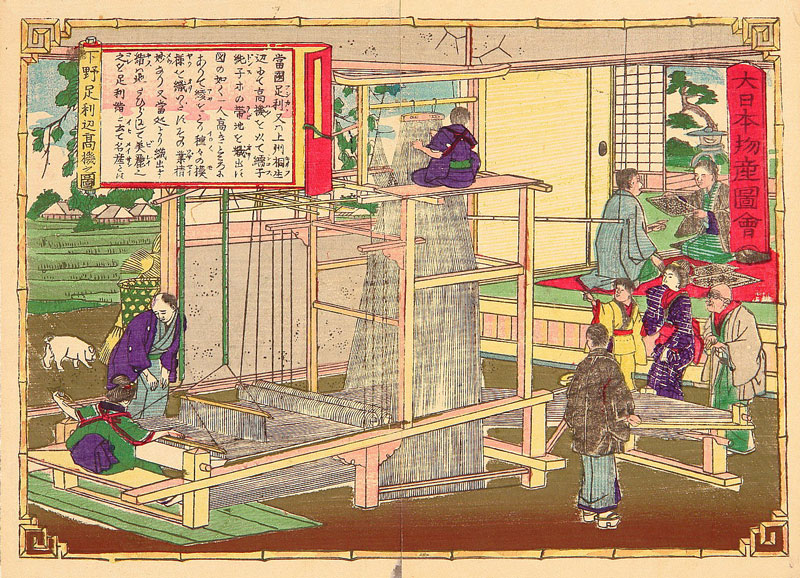 | Silkworm Culture, figure 3 下野国養蠶國 三 High Loom Weaving Near Ashikaga 下野足利辺高機之圖 [下野足利辺高機之図] Shimotsuke Ashikaga takabata hen no zu | Shimotsuke 下野国 Shimotuski no kuni  Modern-day Tochikgi Prefecture (栃木県) |
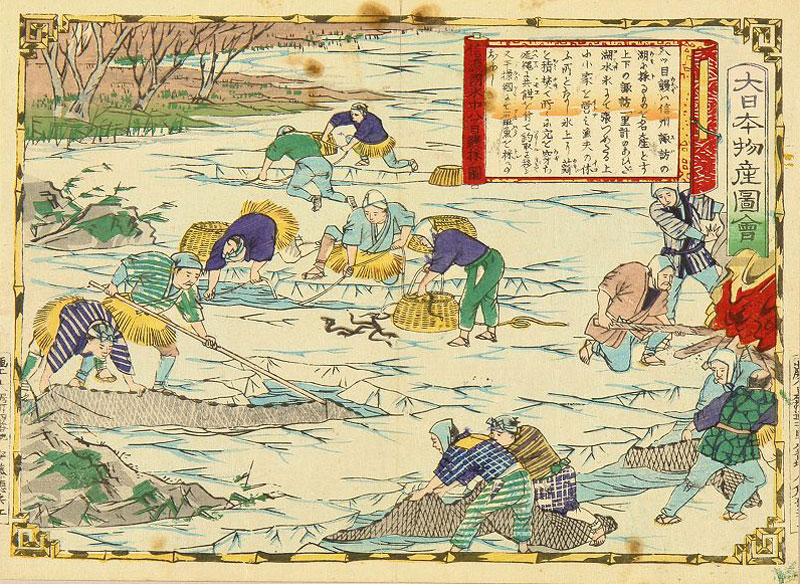 | Making Buckwheat (soba) Noodles 信州蕎麦切製造之図 Shinshū sobakiri seizō no zu Catching Eel Underwater by Eyesight 信濃国氷中八ツ目鰻採ノ図 Shinano no kuni suichū tsu me unagi to no zu | Shinano 信濃国 Shinano no kuni (also known as Shinshū 信州)  Modern-day Nagano Prefecture (長野県) |
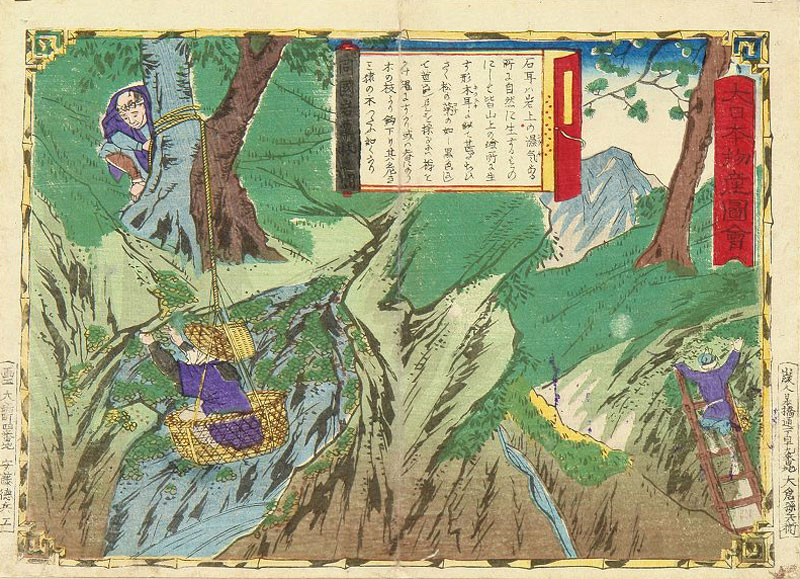 | Planting Shiitake Mushrooms 周防国香茸製之図 [周防国香蕈之図] Suō no kuni kōtake sei no zu Picking Iwatake Mushrooms 同国岩茸採之図 [同国岩蕈採之図] dōkoku iwatake to no zu | Suō 周防国 Suō no kuni (sometimes called Bōshū 防州)  Eastern part of Yamaguchi Prefecture (山口県) |
| | Manufacturing Bamboo Work 駿河國竹細工製ノ図 Suruga no kuni takezaiku sei no zu Papermaking 駿河半紙漉場ノ図 [駿河紙半紙漉場ノ図] Suruga hanshi roku ba no zu | Suruga 駿河国 Suruga no kuni  Central part of modern-day Shizuoka Prefecture (静岡県) |
| Making Wicker Trunks 但馬国柳考老製図 (但馬国柳{タケカンムリ・考} {タケカンムリ・老}製図) Tajima no kuni yanagi (takekanmuri) seizu Cultivating Wild Silkworms 同国[但馬国] 野蚕(蠶)養之図 dōkoku [Tajima no kuni] yasan yō no zu | Tajima 但馬国 Tajima no kuni (sometimes called Tanshū 但州)  Modern-day Hyōgo Prefecture (兵庫県) | |
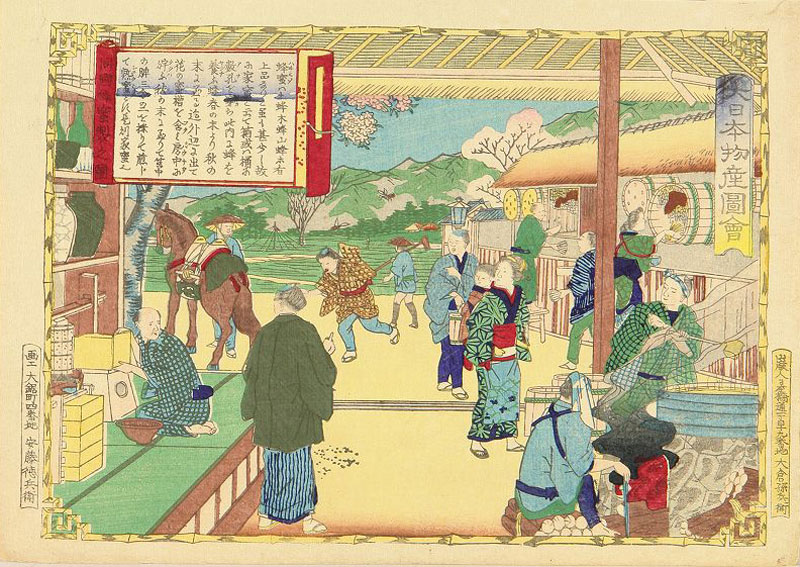 | Cutting Flint Stone 丹波国燧石切出之図 Tanba no kuni hikiri ishikiri de shutsu no zu Honey Making 同国[丹波国]蜂蜜製之図 dōkoku [Tanba no kuni] hachimitsu sei no zu | Tanba 丹波国 Tanba no kuni  Central part of modern-day Kyoto Prefecture (京都府) and the east-central part of Hyōgo Prefecture (兵庫県) |
| | Catching Yellowtail 丹後國鰤追網之図 [丹後国鰤追網之図] Tango no kuni buri ō ami no zu Beach Fishing for Yellowtail 同[丹後国]鰤磯場之図 dō (Tango no kuni) buri isoba no zu | Tango 丹後国 Tango no Kuni  Modern-day northern Kyoto Prefecture (京都府) |
| Fishing for Bonito 土佐国鰹釣之図 Tosa no kuni katsuo tsuri no zu Making Dried Bonito Flakes 同鰹節を製ス図 dō katsuo-bushi o seisu zu | Tosa 土佐国 Tosa no kuni (sometimes called Doshū 土州)  Modern-day Kōchi Prefecture (高知県) | |
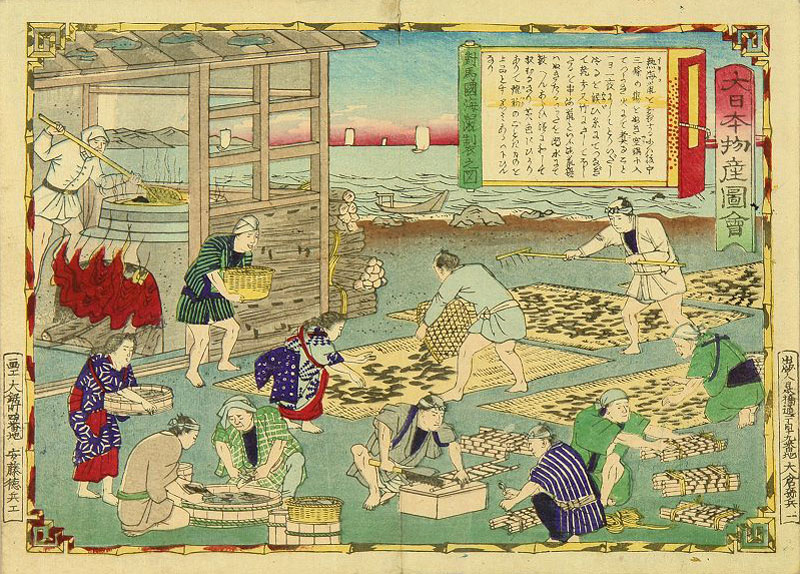 | Catching Sea Cucumbers 対島国海鼠取之図 [対馬国海鼠取之図] Tsushima no kuni namako tori no zu Drying Sea Cucumber 対島国海鼠製之図 [対馬国海鼠製之図] Tsushima no kuni namako sei no zu | Tsushima 対馬国 (also 対島国) Tsushima no kuni (sometimes called Taishū 対州)  Modern-day Tsushima (対馬市), Nagasaki (対馬市) |
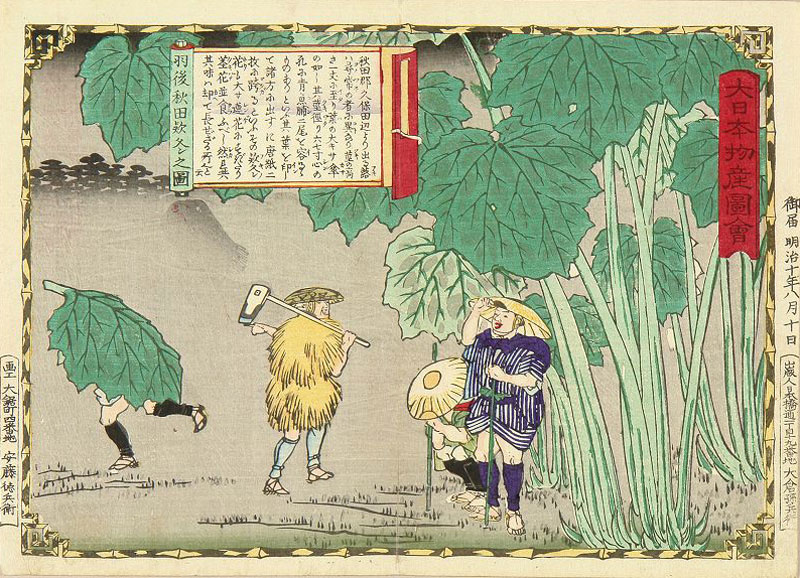 | Sericulture 羽後国養蠶之図 七 [羽後国養蚕之図 七] Ugo no kuni yōsan no zu shichi Giant Butterbur (Japanese sweet coltsfoot) in Akita 羽後秋田欵冬之図 [羽後秋田款冬之図] Ugo Akita fuki no zu | Ugo 羽後国 Ugo no kuni (sometimes called Ushū 羽州)  In the area of modern-day Akita Prefecture (秋田県) and some parts of Yamagata Prefecture (山形県) |
| Fishing for Flatfish 若狭国鰈を取図 Wakasa no kuni karei oto zu Making Steamed Flatfish 同[若狭]蒸鰈製造之図 [同蒸鰈製造之図] dō [Wakasa] mushi karei seizō no zu | Wakasa 若狭国 Wakasa no kuni (also known as Jakushū 若州 or Reinan 嶺南)  Southern modern-day Fukui Prefecture (福井県) | |
| Picking Uji Tea, figure 1 山城国宇治茶摘図 一 Yamashiro no kuni Uji chatsumi zu ichi Producing Uji Tea, figure 2 山城国宇治茶製之図 二 Yamashiro no kuni Uji cha sei no zu ni | Yamashiro 山城国 Yamashiro no kuni  Overlaps southern part of modern-day Kyoto Prefecture (京都府) | |
| | Digging Kudzu [pueraria] Root 大和国葛根堀図 Yamato no kuni kakkon hori zu Making Arrowroot Powder 大和国葛之粉製図 Yamato no kuni kazura no kona sei zu | Yamato 大和国 Yamato no kuni  Modern-day Nara Prefecture (奈良県) |
last revision:

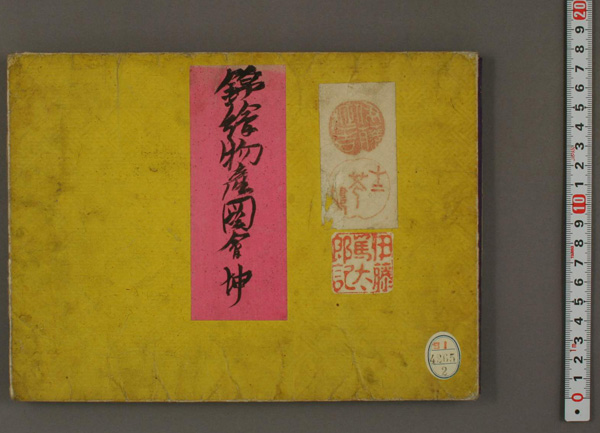
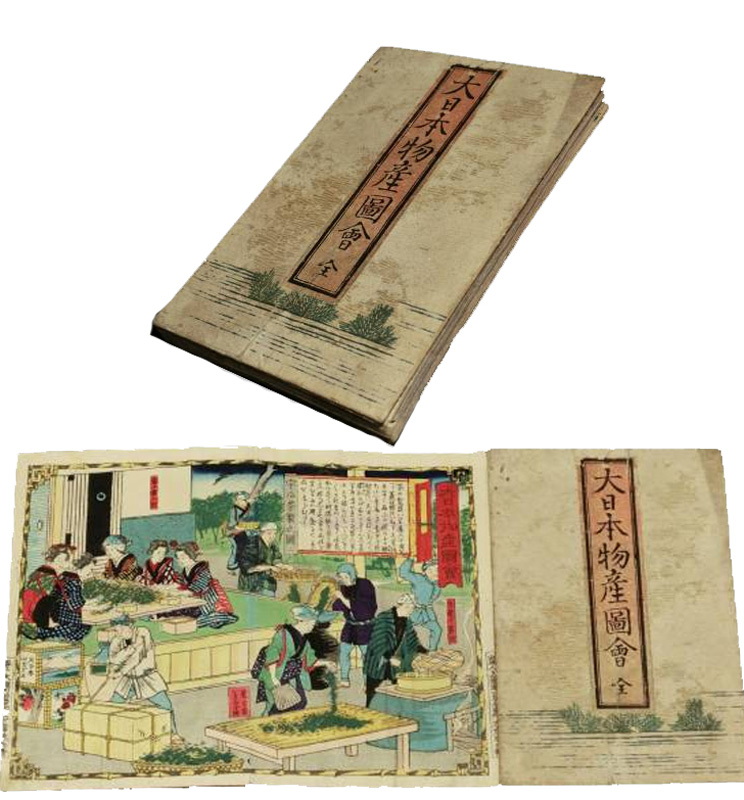
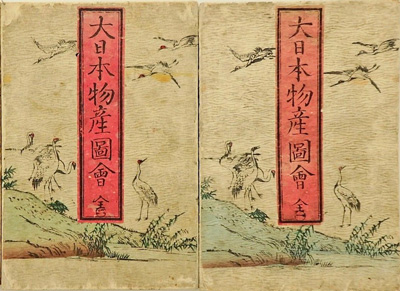

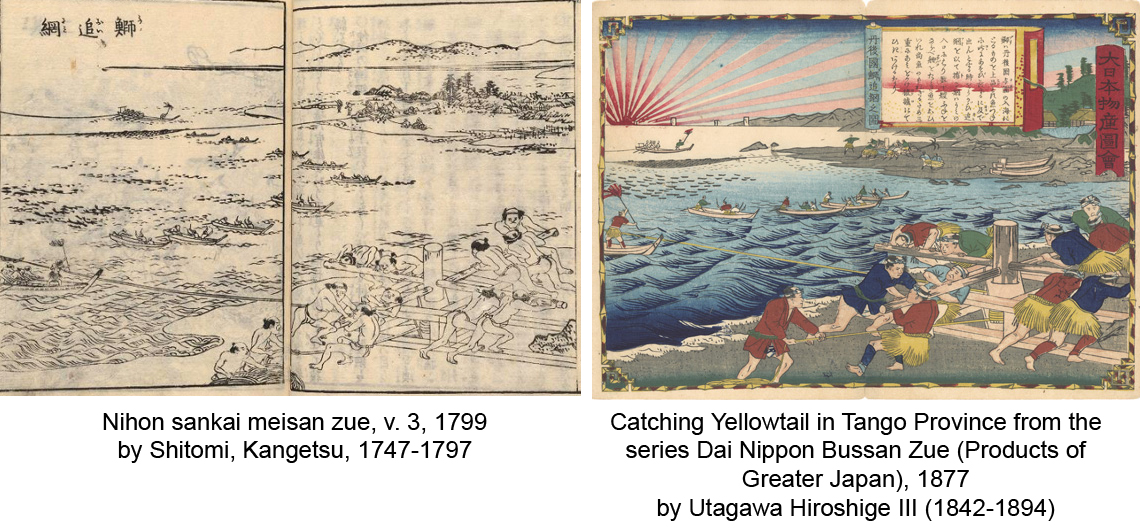
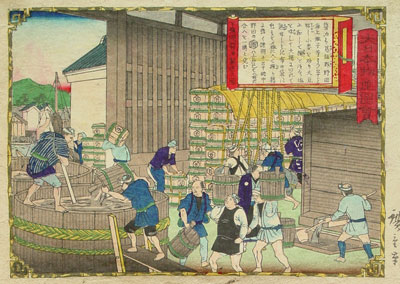
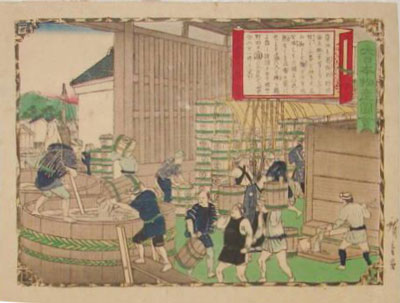

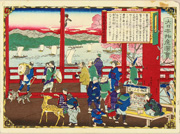
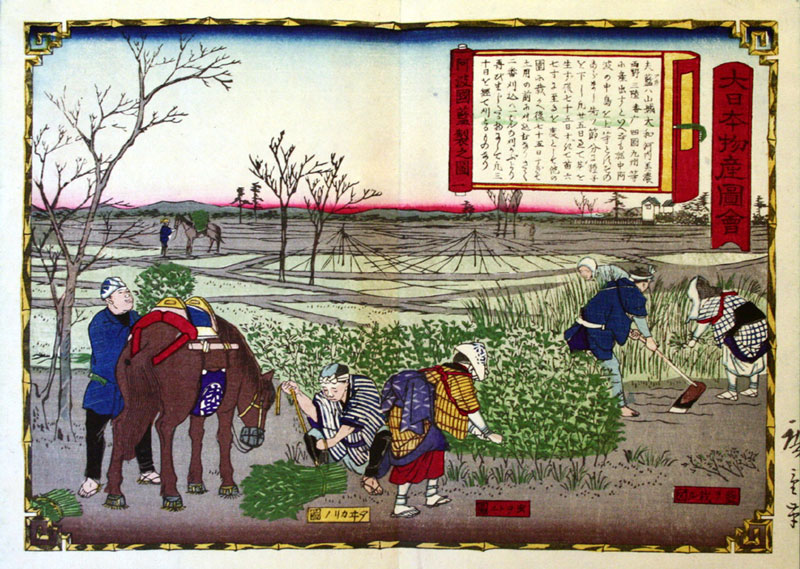

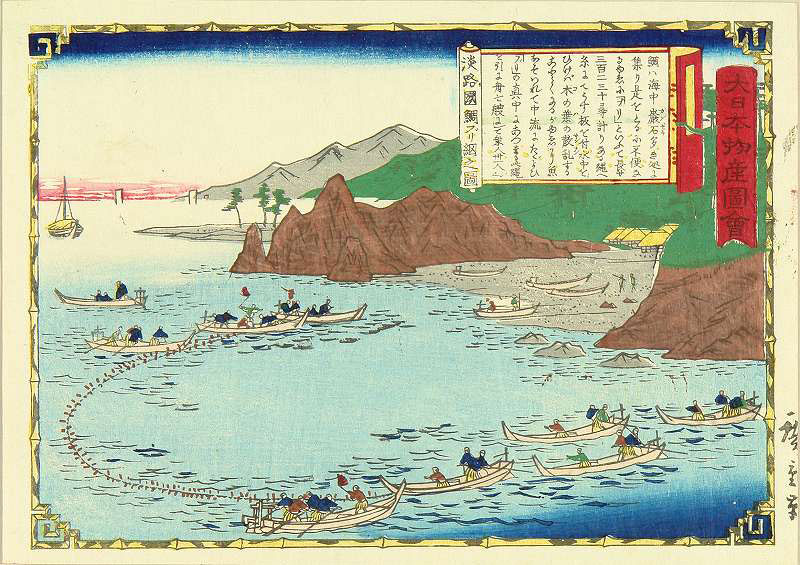
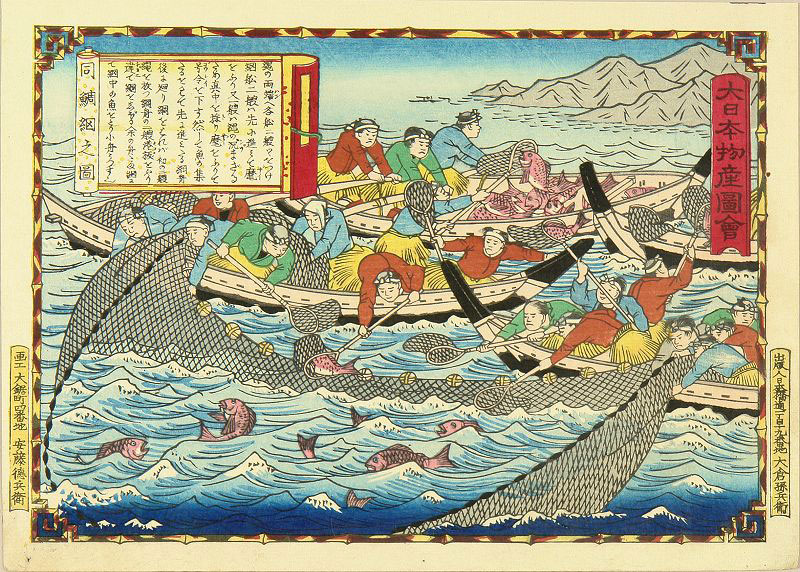
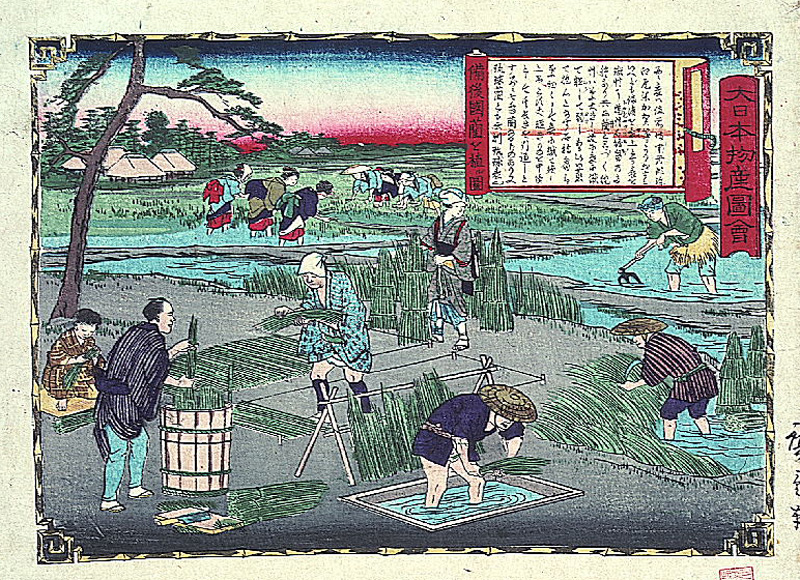
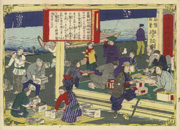
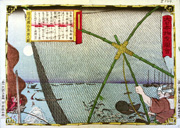

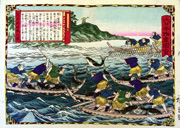
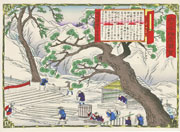
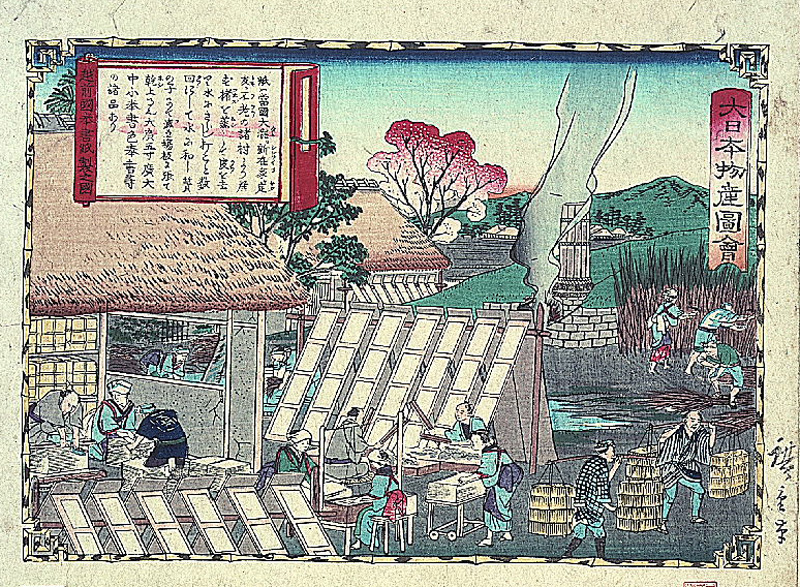
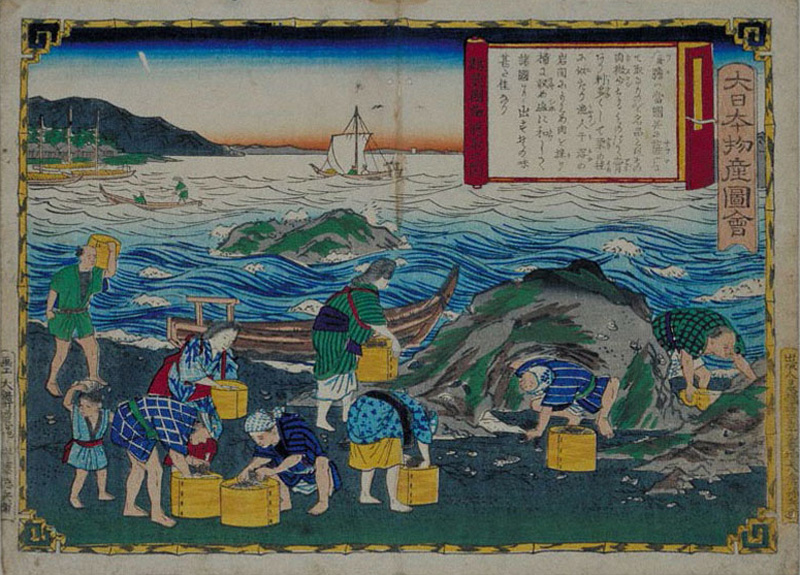

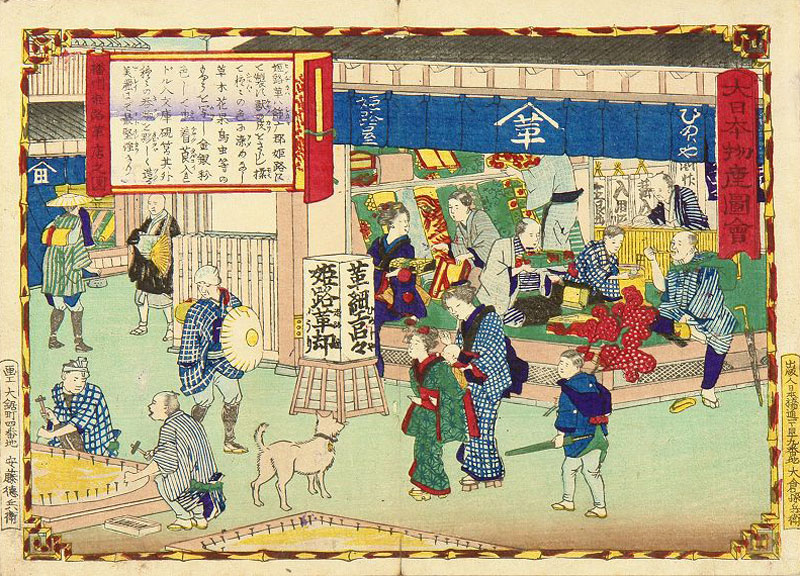


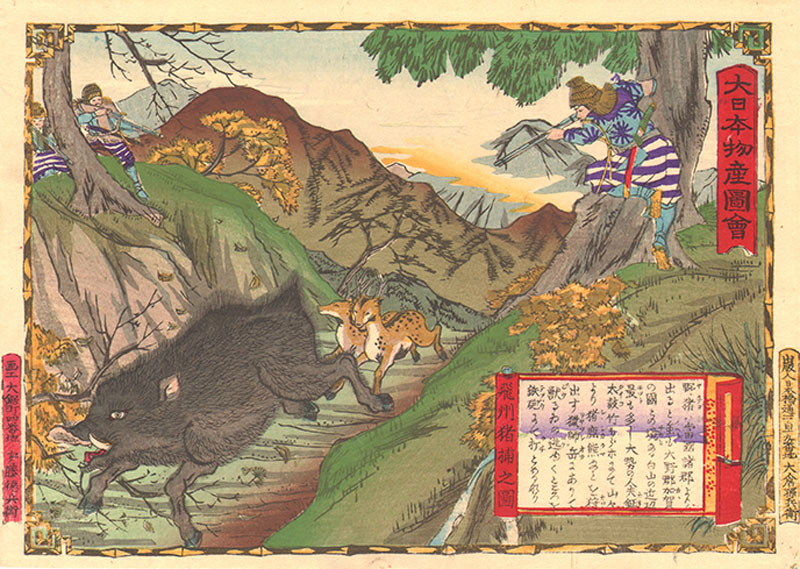
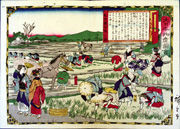

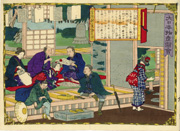
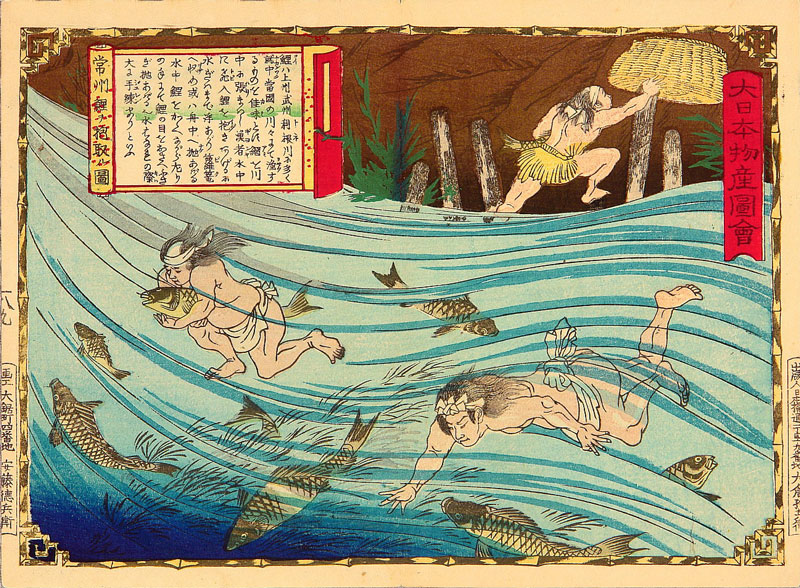
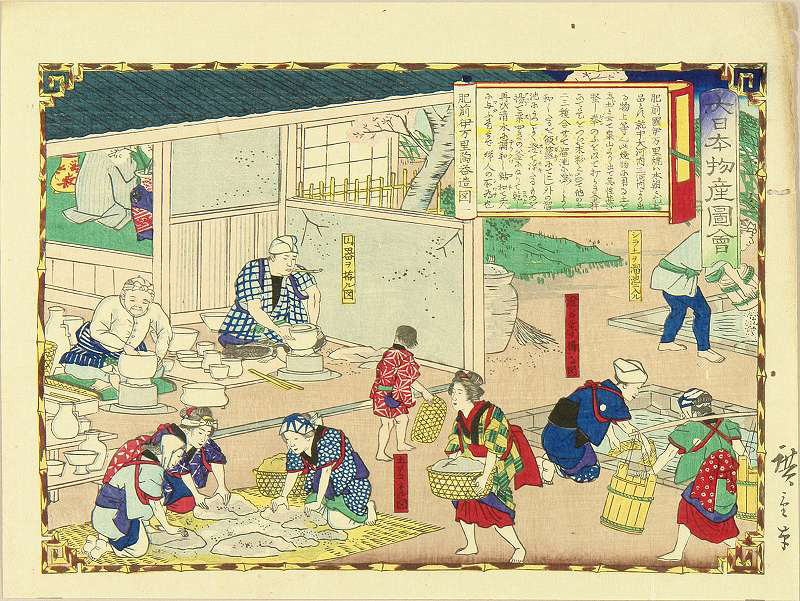
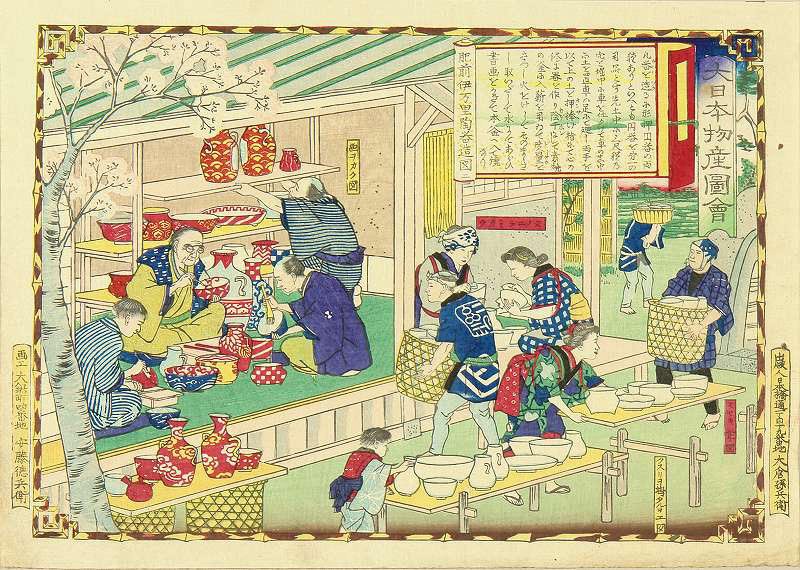
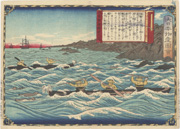
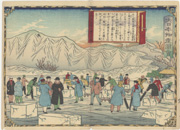

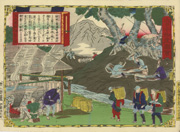
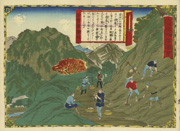
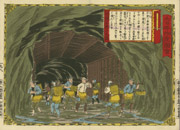
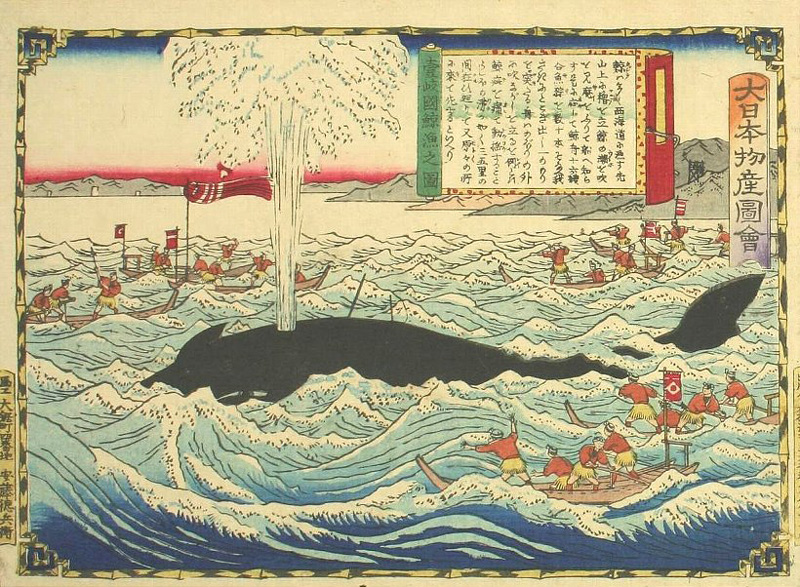
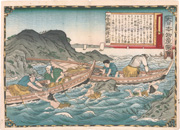
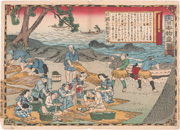
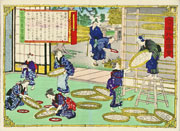
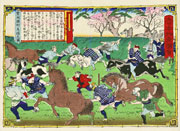
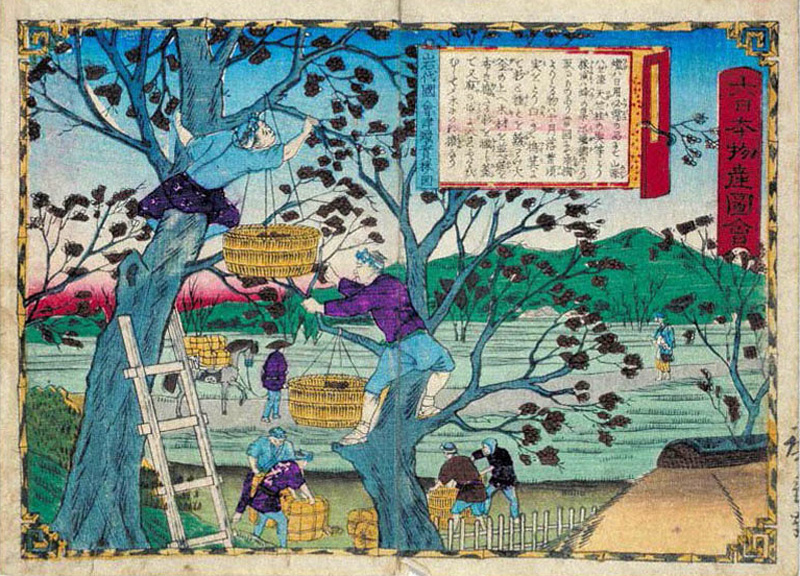
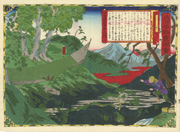
![Crane Hawk [falconry], Figure 2 in Iyo Province Figure 1 from the series Dai Nippon Bussan Zue (Products of Greater Japan)](../artists/utagawa-hiroshige-iii-1842-1894/Crane hawk falconry figure 2 -55e0525ffc3c9ebe.jpg)
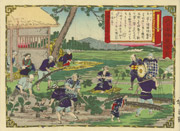
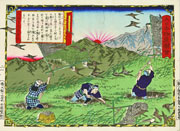
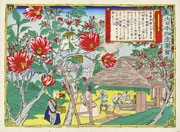
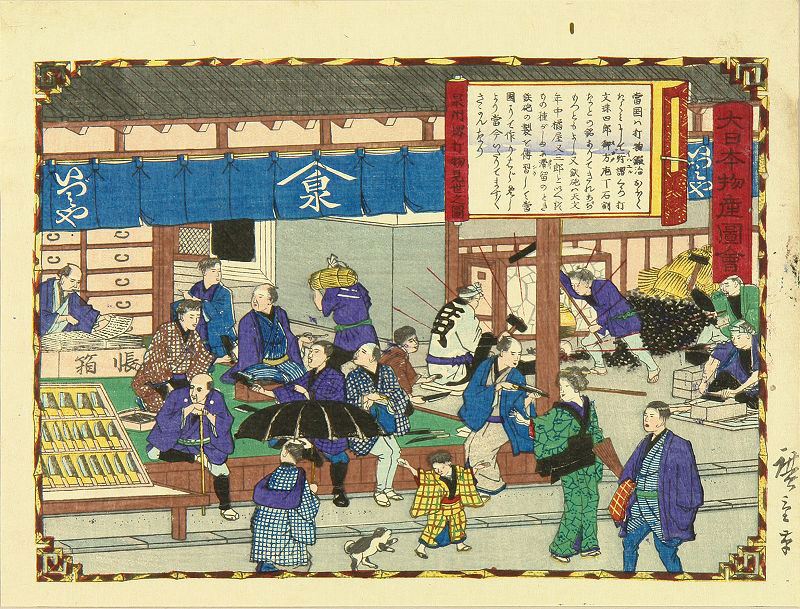
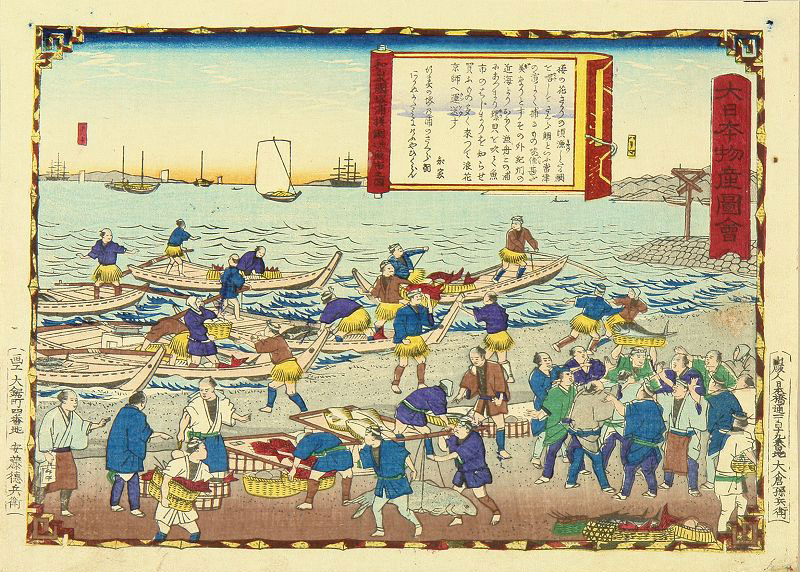
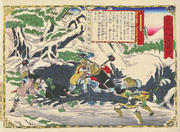


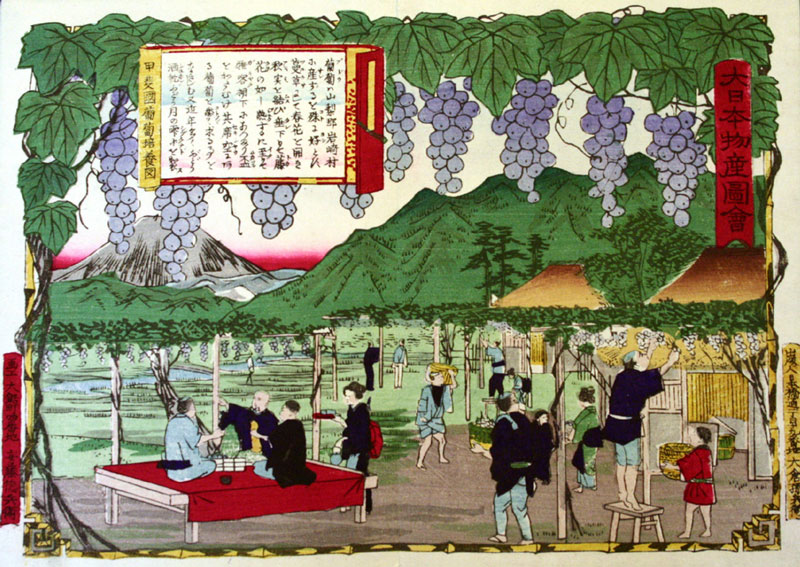
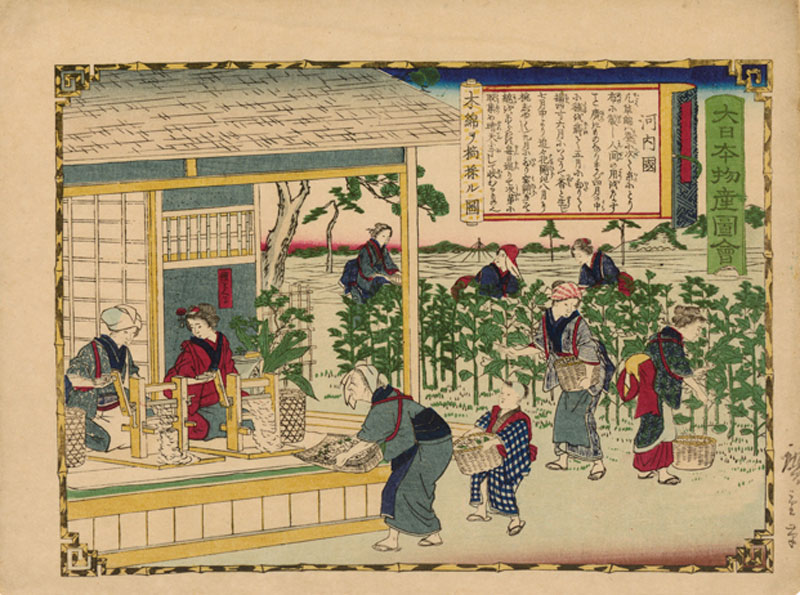
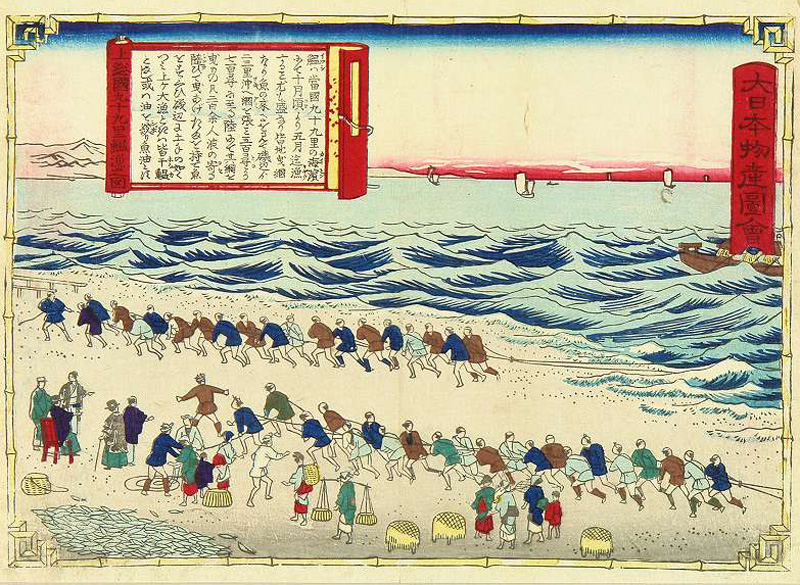
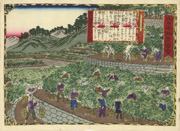
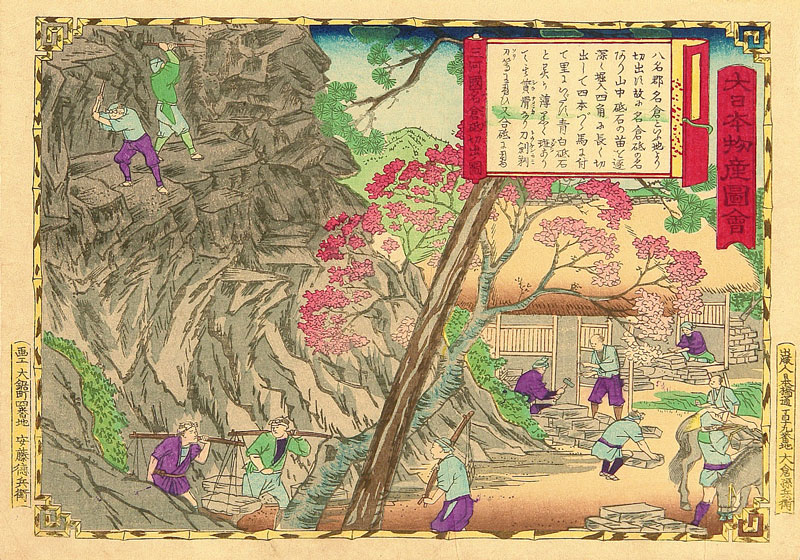

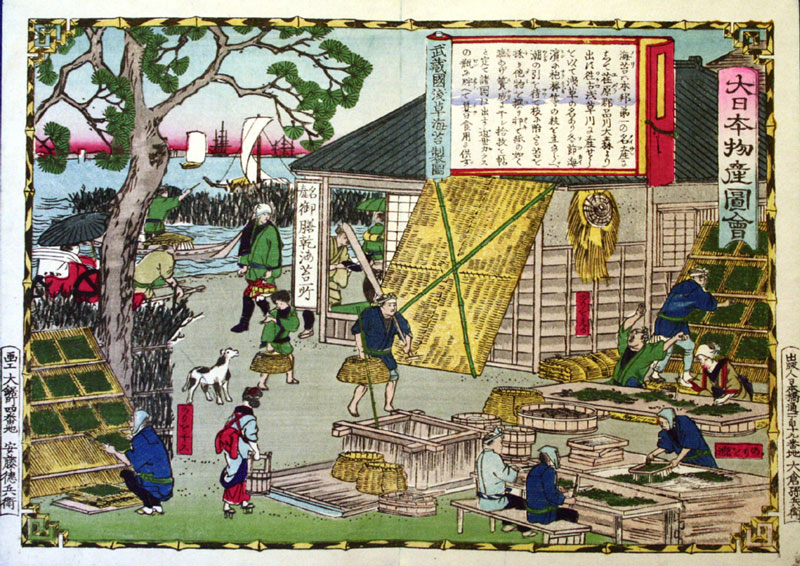

 in -6e25dd3ecc2039af.jpg)
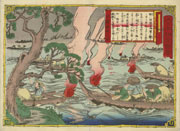
,--a6bad122a300cc88.jpg)
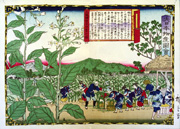


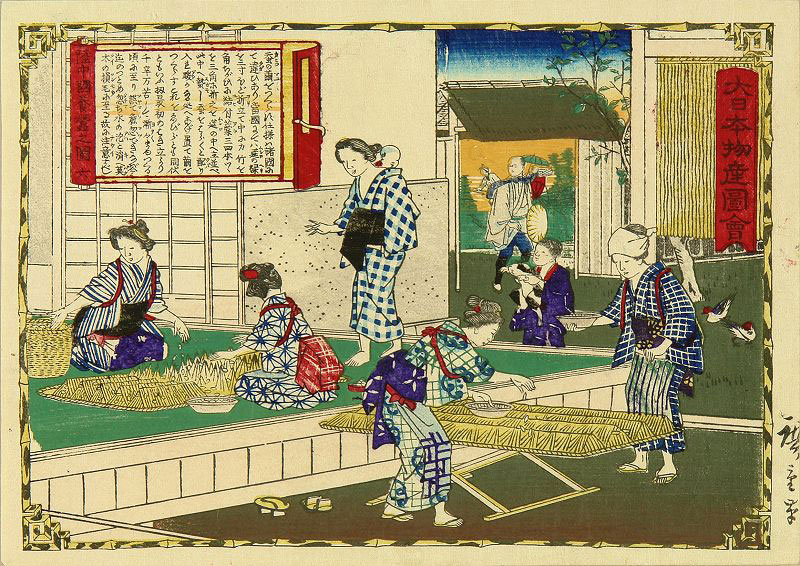
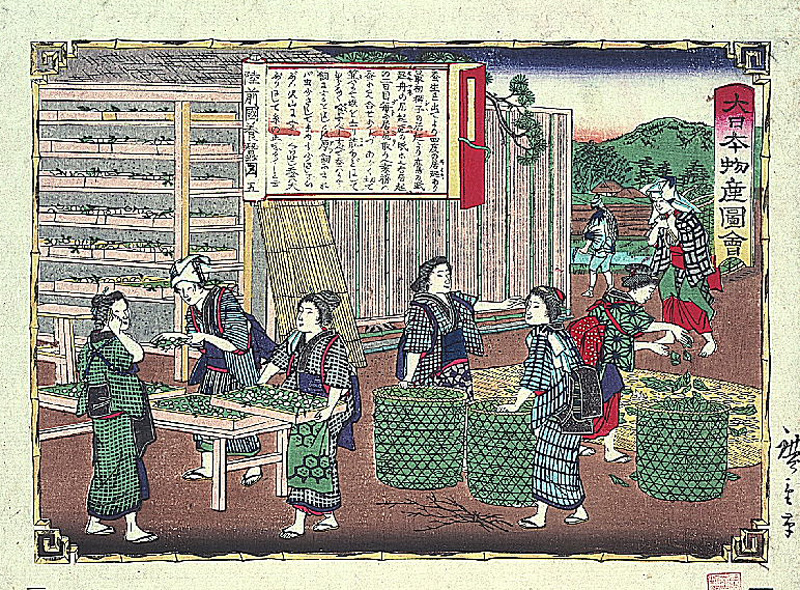
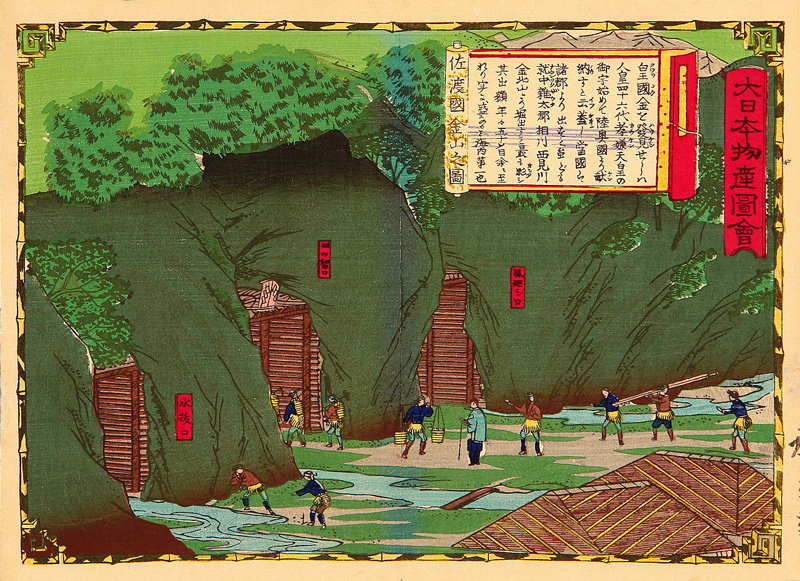

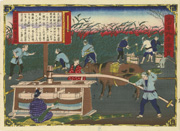
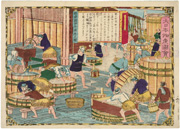
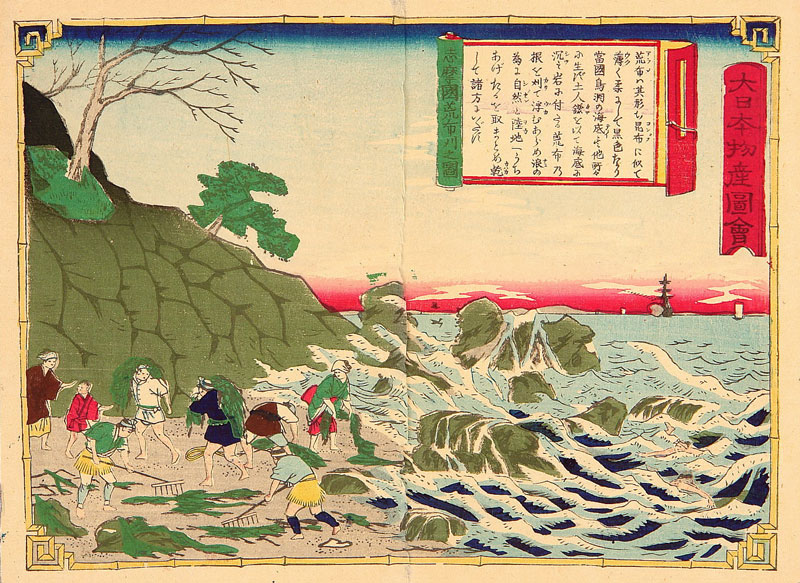
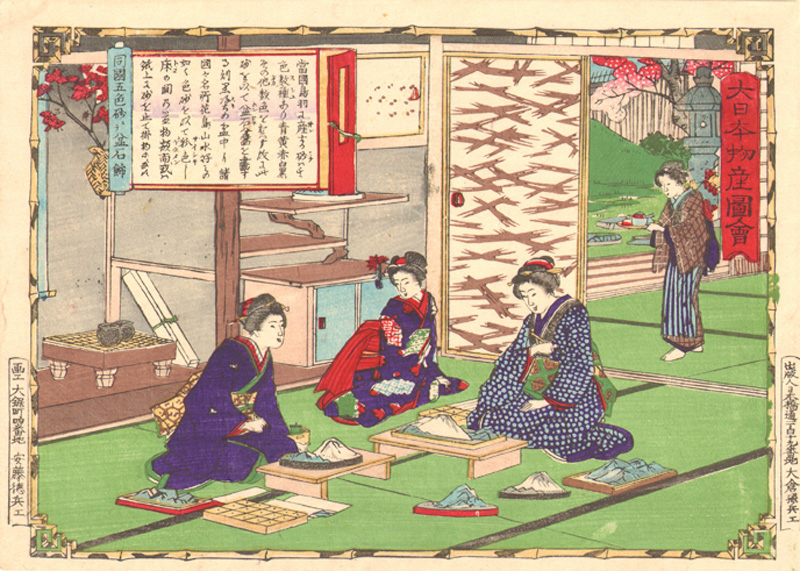
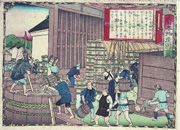
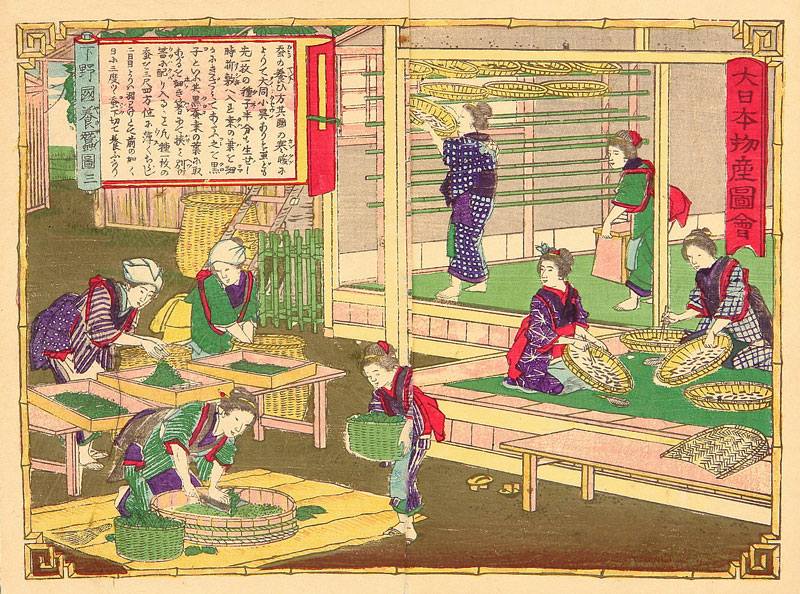
-noodle-cf3de61aca01b96.jpg)

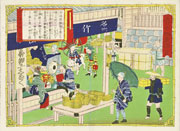

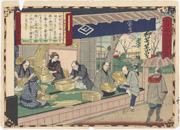
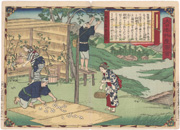
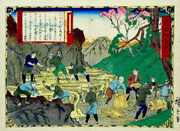
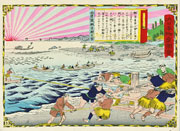
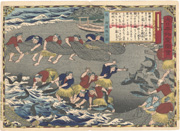
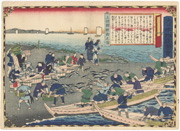
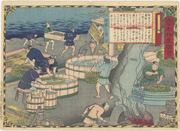


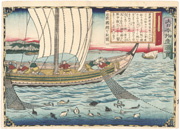
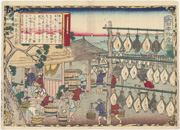
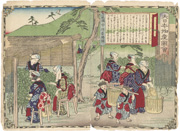
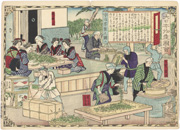
![Digging Kudzu [Pueraria] Root from the series Dai Nippon Bussan Zue (Products of Greater Japan) in Yamato Province](../artists/utagawa-hiroshige-iii-1842-1894/Digging pueraria root in Yama-d55172e0607e1d84.jpg)
